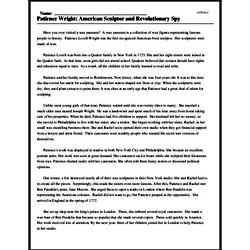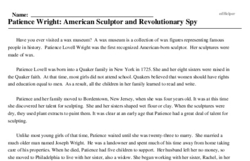Patience Wright: American Sculptor and Revolutionary Spy
Have you ever visited a wax museum? A wax museum is a collection of wax figures representing famous people in history. Patience Lovell Wright was the first recognized American-born sculptor. Her sculptures were made of wax.
Patience Lovell was born into a Quaker family in New York in 1725. She and her eight sisters were raised in the Quaker faith. At that time, most girls did not attend school. Quakers believed that women should have rights and education equal to men. As a result, all the children in her family learned to read and write.
Patience and her family moved to Bordentown, New Jersey, when she was four years old. It was at this time she discovered her talent for sculpting. She and her sisters shaped wet flour or clay. When the sculptures were dry, they used plant extracts to paint them. It was clear at an early age that Patience had a great deal of talent for sculpting.
Unlike most young girls of that time, Patience waited until she was twenty-three to marry. She married a much older man named Joseph Wright. He was a landowner and spent much of his time away from home taking care of his properties. When he died, Patience had five children to support. Her husband left her no money, so she moved to Philadelphia to live with her sister, also a widow. She began working with her sister, Rachel, in her small wax-modeling business there. She and Rachel soon opened their own studio when they got financial support from a lawyer and artist friend. Their customers were wealthy people who wanted life-sized wax versions of themselves.
Patience's work was displayed in studios in both New York City and Philadelphia. She became an excellent portrait artist. Her work was soon in great demand. Her customers sat for hours while she sculpted their likenesses from wax. Patience chatted easily with her customers. She often told them funny stories or discussed political opinions.
One winter, a fire destroyed nearly all of their wax sculptures in their New York studio. She and Rachel had to re-create all the pieces. Surprisingly, this made the sisters even more famous. After this, Patience and Rachel met Ben Franklin's sister, Jane Mecom. She urged them to open a studio in London where Ben Franklin was representing the American colonies. Rachel did not want to go, but Patience jumped at the opportunity. She arrived in England in the spring of 1772.
She set up shop near the king's palace in London. There, she enlisted several royal customers. She made a wax bust of Ben Franklin that became so popular that she made several copies. These sold quickly in America. Her work received lots of attention. By the next year, three of her children joined her in London to help Patience in her studio.
Patience was soon invited to Buckingham Palace to create wax busts of the king and queen. She used these sessions to discuss the politics of the American colonies with King George. She urged the king and his lords not to wage war on the colonies.
As she continued to work on her sculptures, she found herself offering wrong information to the British officers. This led them to reveal secrets regarding their plans. Patience became a Revolutionary spy for the American colonies when she passed on this information to the colonial leaders.




